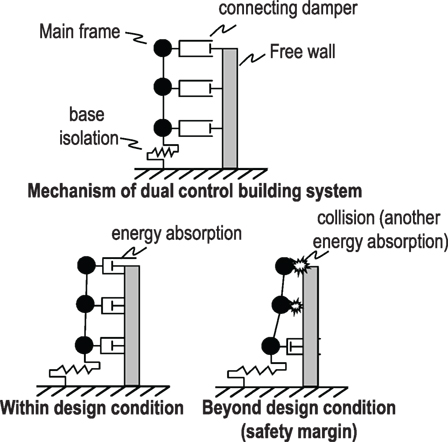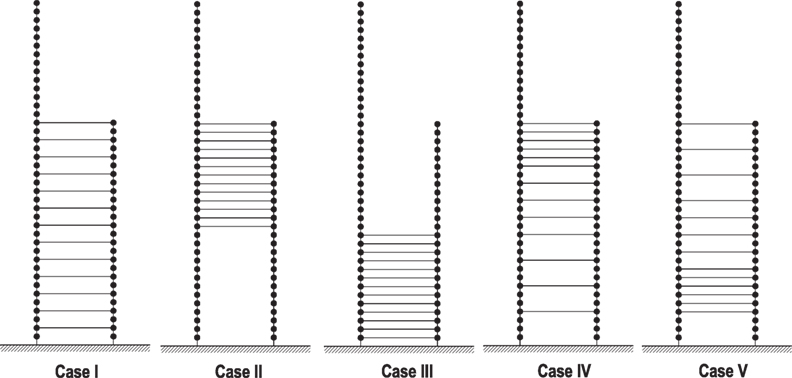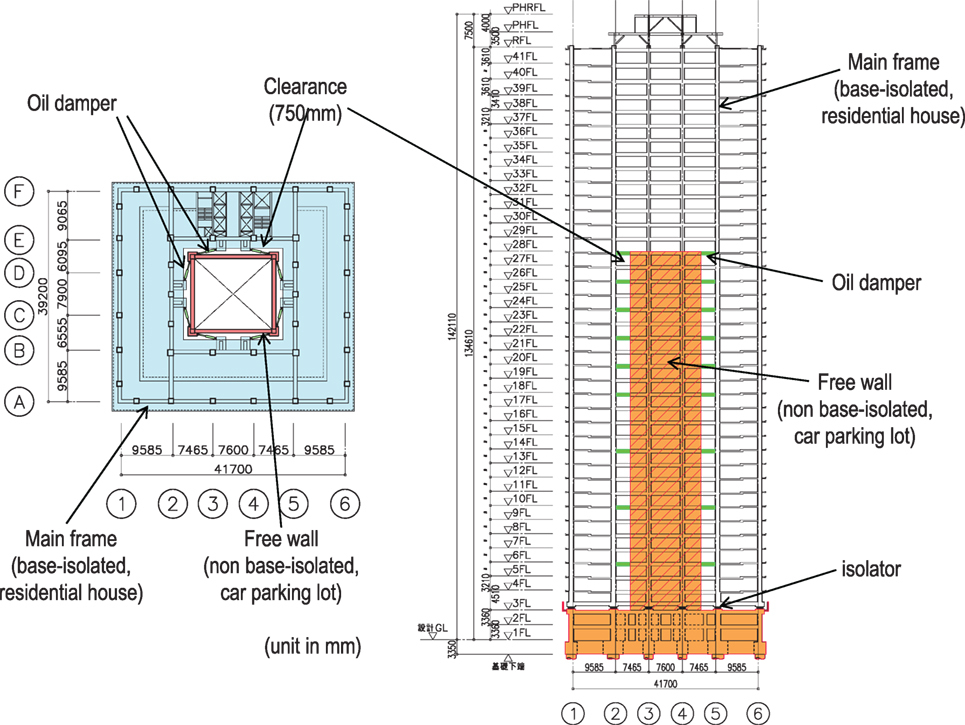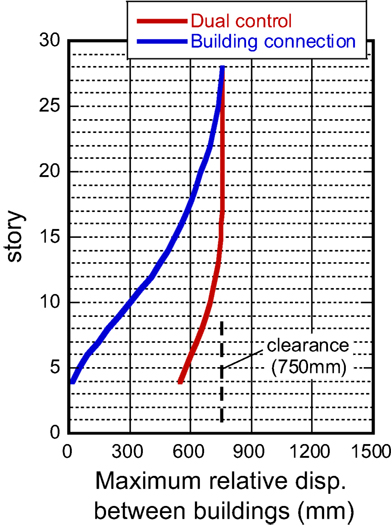- 1Department of Architecture and Architectural Engineering, Graduate School of Engineering, Kyoto University, Kyoto, Japan
- 2Obayashi Corporation, Osaka, Japan
A dual passive control system is proposed for high-rise buildings. Since the proposed system needs a substructure supporting the main building, it is usually used in high-rise residential apartment houses where a parking tower is used as the substructure. This new system consists of a base-isolation system and a building-connection system. While base-isolated buildings and interconnected buildings are effective for special earthquake ground motions, i.e., impulsive type and long-duration type, respectively, a building structure with such system as robust for both type inputs has never been proposed and investigated in detail. Although some attempts have been conducted, realization of such systems has never been accomplished. In this paper, not only the theoretical background but also the actual installation in a real world is presented in detail. It is shown that the transfer function of the proposed dual building control system possesses lower values in a broader frequency range compared to the conventional building-connection system. This supports the high robustness of the proposed dual building system. It is also shown that the optimal connecting damper quantity providing a lower response of the main frame can be obtained by maximizing the area of energy transfer function which implies the energy absorption of the connecting dampers under an idealized white noise-like input.
Introduction
After the experience of various kinds of earthquake damage all over the world, most structural engineers are seeking for resilient structures that are tough for extreme disturbances and can recover fast from the disruption (Bruneau and Reinhorn, 2006; Takewaki et al., 2012). They are trying to increase the earthquake resilience of building structures by introducing updated design methodologies and new techniques effective for broader types of earthquake ground motions (Amadio et al., 2003; Kobori, 2004; Takewaki et al., 2012, 2013; Takewaki, 2013). In this regard, high uncertainty in the understanding of earthquake ground motions is becoming an obstacle for such objective (Takewaki, 2013; Takewaki et al., 2011, 2012, 2013). In addition, variability in building structural properties (especially the properties of base-isolation systems and passive control system, etc.) should be included appropriately (Ben-Haim, 2006; Takewaki et al., 2012). In these circumstances around the seismic-resistant design of building structures, it is expected that the investigation on the role of robustness and redundancy is becoming extremely important. For example, it is mandatorily required in Japan to consider the initial and temporal variability in structural properties of isolators and dampers in the design of base-isolated and passively controlled buildings because of the high variabilities of such materials’ properties and responses. In such design procedure, the worst combination and scenario are often investigated in detail (Ben-Haim, 2006; Takewaki et al., 2012).
Historically base-isolated buildings have been used primarily in New Zealand, Japan, China, and US and various types of base-isolated buildings have been proposed principally for pulse-type ground motions (Jangid and Datta, 1994; Hall et al., 1995; Heaton et al., 1995; Jangid, 1995; Kelly, 1999; Naeim and Kelly, 1999; Jangid and Kelly, 2001; Morales, 2003; Takewaki, 2005, 2008; Li and Wu, 2006; Hino et al., 2008; Takewaki and Fujita, 2009). However, their resilience after earthquakes has never been demonstrated properly and guaranteed for long period ground motions with the characteristic period of 5–8 s (Irikura et al., 2004; Kamae et al., 2004; Ariga et al., 2006). This problem is related to the resonance of the base-isolated buildings to such ground motions (Hashimoto et al., 2015). The long period ground motions of the characteristic period of 5–8 s were of great interest in the structural design of base-isolated buildings and super high-rise buildings since the Northridge earthquake in 1994 and the Tokachi-oki earthquake in 2003. This type of input was demonstrated as a key critical input for such buildings during the 2011 off the Pacific coast of Tohoku earthquake. On the other hand, it is also controversial that while building structures with passive energy dissipating systems are effective for long duration and long period ground motions (Takewaki, 2007; Patel and Jangid, 2011; Takewaki et al., 2011, 2012; Kasagi et al., 2015), they are not necessarily effective for pulse-type ground motions. This is because these smart structures with viscous-type dampers can not necessarily resist the impulsive input such as near-fault ground motions effectively due to the delay of velocity response in such dampers. The resolution of these two issues is of great importance in the seismic-resistant and control design (Koo et al., 2009; Petti et al., 2010; Karabork, 2011).
There are only two types of base-isolated high-rise buildings in a real world, i.e., one is a base-isolated high-rise building without connection and the other is the proposed one connected to a substructure with dampers. A multiple isolation system (one isolation system at base and the other at middle story) has been proposed theoretically (Becker and Ezazi, 2016; Fujita et al., 2016), but that has never been realized up to now.
In this paper, a new dual passive control building system is proposed in which a base-isolated building structure is connected to another non-isolated building (free wall) with oil dampers. Since the proposed system needs a substructure supporting the main building, it is usually used in high-rise residential apartment houses where a parking tower is used as the substructure. The connected buildings without base isolation and another type of base-isolated buildings with connection of other type have been designed and constructed by Obayashi Corporation and Shimizu Corporation in Japan in the form of a high-rise apartment house with a car parking tower (Murase et al., 2013; Kasagi et al., 2016). However, the effective quantity of connecting dampers and their influences on earthquake responses have never been made clear. It is demonstrated here that the proposed dual building control system is effective both for pulse-type ground motions and long-duration, long-period ground motions. Finally, the actual installation of the proposed dual control system in the real world is presented in detail.
Dual Passive Control System Using Base Isolation and Building Connection
Proposed Building Model and Other Comparable Model
Consider a 40-story high-rise reinforced concrete building, as shown in Figure 1, which is base isolated and is connected by oil dampers to a reinforced concrete free wall of 26 stories (a RC wall system) at some floor levels (4, 8, 12, 16, 18, 20, 22, 24, and 26th floor levels). About 40-story buildings are actually used because of the performance limitation of isolators. The isolators used in this study are considered to be linear for simple presentation of the proposed system. This dual control system has been dealt with previously (Murase et al., 2013). However, the effective quantity of connecting dampers and the earthquake response properties of such dual control system have never been made clear sufficiently.
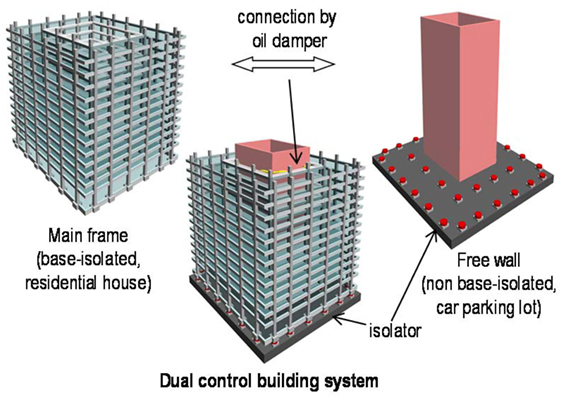
Figure 1. Proposed dual control building system consisting of base-isolated residential house and free wall (car parking lot).
On the one hand, the fundamental natural period of the base-isolated model without connection is 6.83 s and that of the free wall is 0.61 s (SNAP, 2015). On the other hand, the fundamental natural period of the non-isolated model without connection is 3.78 s. The horizontal stiffness of the isolation story can be regarded as the equivalent stiffness after consideration of the P-delta effect. The structural damping ratio of the super-structure (stiffness-proportional damping) is set to 0.03.
Transfer Function of Proposed Dual Control System
Figure 2 shows the displacement transfer functions of the independent main structure, independent substructure (free wall), and rigidly connected building together with the main structure and substructure in the connected building for the dual control system and the building-connection system. The transfer function can be obtained from the equations of motion in frequency domain (Murase et al., 2013). In the connected building, the optimal connecting damper derived from the fixed-point theory (Den Hartog, 1956) is used.
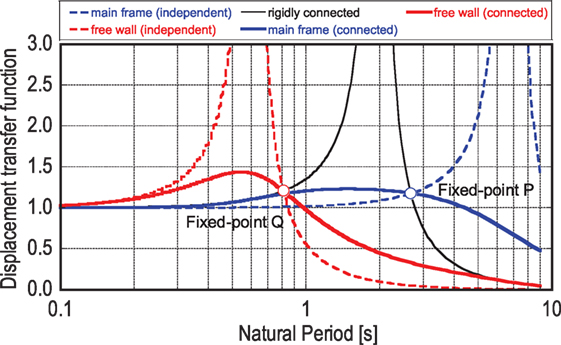
Figure 2. Displacement transfer functions of independent main structure, independent substructure (free wall), and rigidly connected building together with main structure and substructure in connected building.
Possible Scenarios in Proposed Dual Control System
Figure 3 illustrates two possible scenarios in the proposed dual control system. While the proposed system responds without collision under the design earthquake ground motion, the collision between two structures may be allowed for inputs beyond the design earthquake ground motion. Some energy may be absorbed during the collision, and this will act as a mechanism for guaranteeing the safety margin. Since the natural period of the main building is 6.83 s and too long, the collision occurs in a very slow movement. Therefore, no damage is expected. The concrete strength is designed appropriately to avoid any damage.
Optimal Damper Quantity
The effective connection damper quantity is an interesting issue. The conventional theory for finding the optimal damper quantity is the “fixed-point theory” (Den Hartog, 1956). Figure 4 shows the displacement transfer functions of the independent main structure, independent substructure, and rigidly connected building together with the main structure and substructure (free wall) in the connected building for the dual control system and the building-connection system. In the connected building, the optimal connecting damper derived from the fixed-point theory is used. However, this theory has some drawbacks: (1) limitation to a two-degree-of-freedom model and (2) limitation to undamped structural models. In order to remove these limitations and find the optimal quantity, the area of the energy transfer function (Takewaki, 2007) for the connection dampers is adopted as the objective function for maximization. The energy transfer function (Takewaki, 2007) for the connection dampers can be expressed as
where m is the number of locations of connecting dampers and are the damping coefficients of connecting dampers. In addition, and are the displacement transfer function of the main frame and the free wall, respectively. This quantity (area of energy transfer function) indicates the energy absorption in the connecting dampers under an ideal white noise-like input.
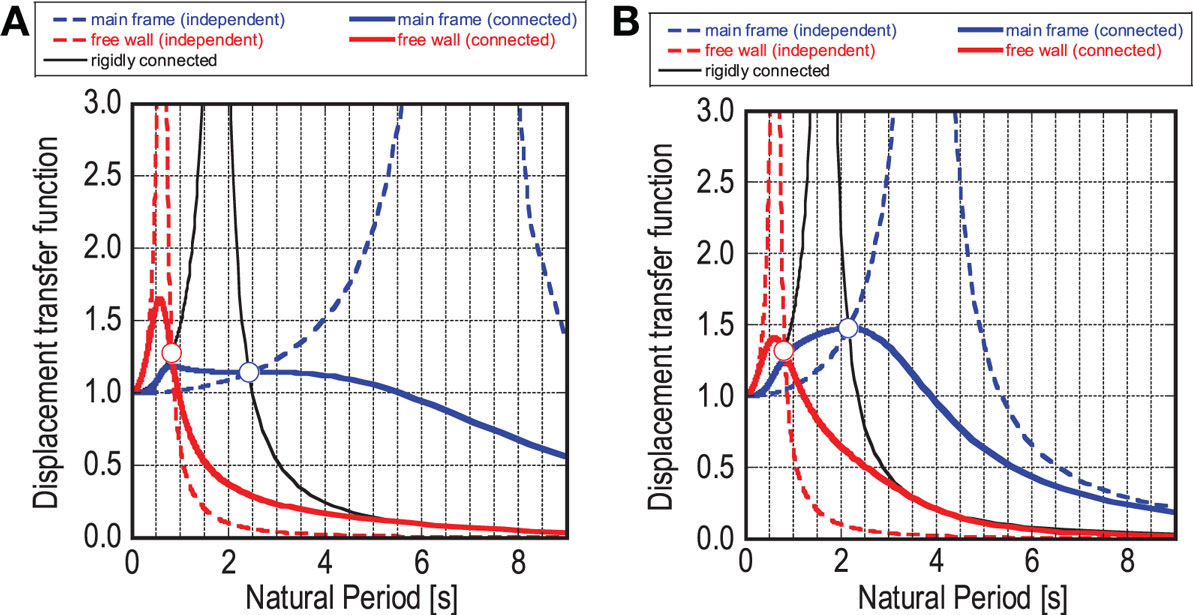
Figure 4. Displacement transfer functions of independent main structure, independent substructure, and rigidly connected building together with main structure and substructure in connected building: (A) dual control system and (B) building-connection system.
Depending on the location of the connecting dampers, consider five models as shown in Figure 5 (Cases 1, 2, 3, 4, and 5). Since the dual control system and the building-connection system are treated, the mass, stiffness, and damping coefficients of these models are specified independently as follows:
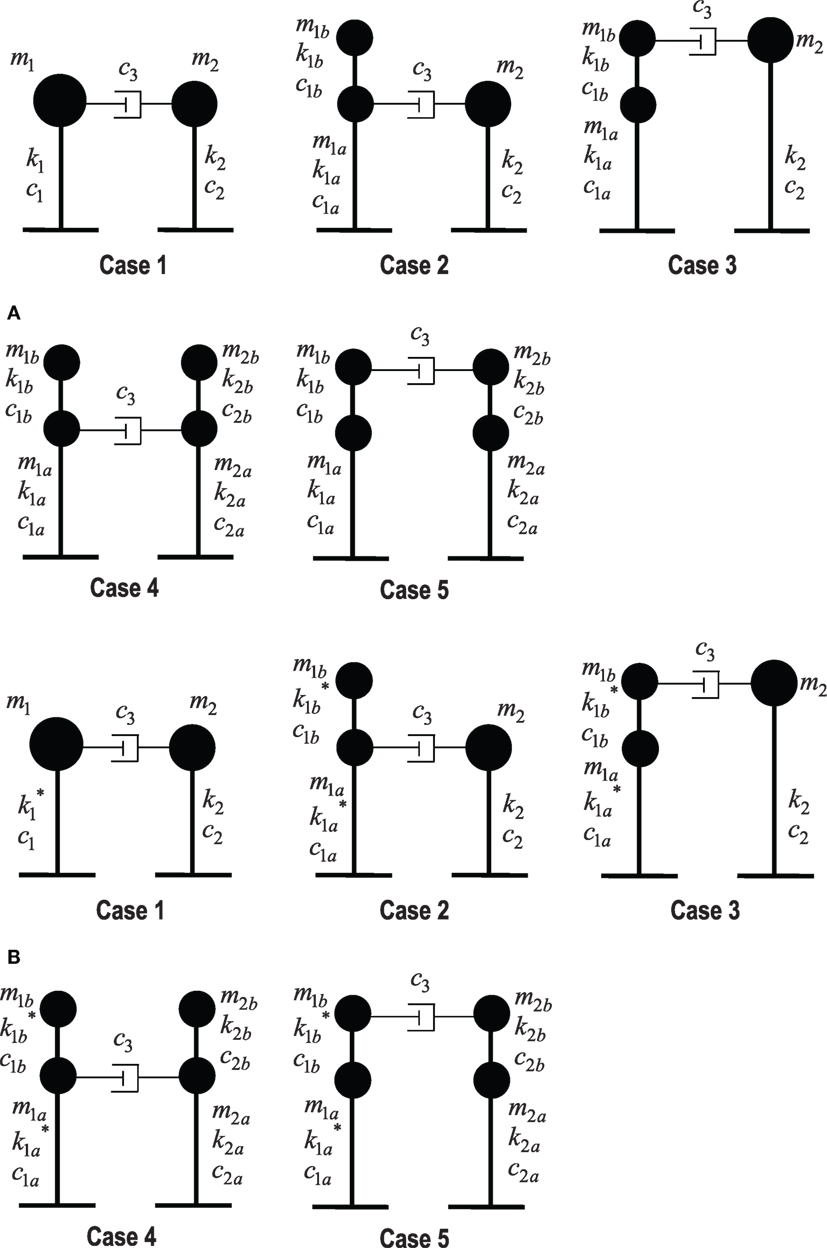
Figure 5. Five models with various locations of connecting dampers: (A) dual control system and (B) building-connection system.
Mass (common for dual control system and building-connection system)
Stiffness and damping (dual control system)
Stiffness and damping (building-connection system)
On the one hand, Figure 6A shows the area of the energy transfer function for five models (Cases 1, 2, 3, 4, and 5) of the building-connection system with respect to the damping coefficient of the connecting damper. On the other hand, Figure 6B presents that of the dual control system. It can be observed that a damper damping coefficient maximizing the area of the energy transfer function exists in each model of the building-connection system and the dual control system. For reference, the optimal value of the damper damping coefficient for Case 1 derived from the fixed-point theory is also plotted by a vertical line. It can be observed that the optimal value of the damper damping coefficient for Case 1 derived from the fixed-point theory corresponds approximately to the value maximizing the area of the energy transfer function. In other words, although the damper damping coefficients maximizing the area of the energy transfer function are different depending on the models in Figure 5, the average value of these corresponds approximately to the value derived from the fixed-point theory. Furthermore, it can be seen that the area of the energy transfer function exhibits a stable and an enhanced characteristic irrespective of the location of connecting dampers in the proposed dual control system. This certainly supports the robust effectiveness of the proposed dual control system.
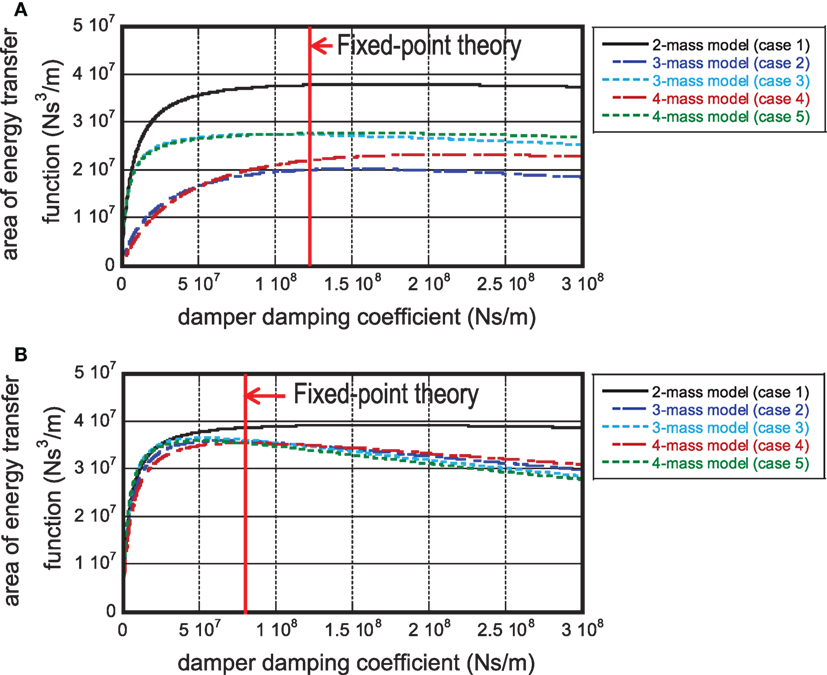
Figure 6. Energy transfer function for five models (Cases 1, 2, 3, 4, and 5) with respect to the damping coefficient of the connecting damper: (A) building-connection system and (B) dual control system.
Effective Damper Distribution
In order to investigate the effective damper distribution, five models (Cases I, II, III, IV, and V) as shown in Figure 7 are considered. In every case, 13 connections are used and the damper distribution is uniform. Each model is analyzed by using a shear-bending model. Figure 8 shows the energy transfer functions for five models (Cases I, II, III, IV, and V) of various damper distributions for the building-connection system and dual control system with respect to the total damping coefficient of the connecting damper. It can be observed that, while a similar tendency can be seen except in Case III in the building-connection system, a common stable property exists in the dual control system. It can be understood that the proposed dual control system possesses a stable and enhanced property in the energy absorption irrespective of damper distributions. This certainly supports the robustness of the proposed dual control system.
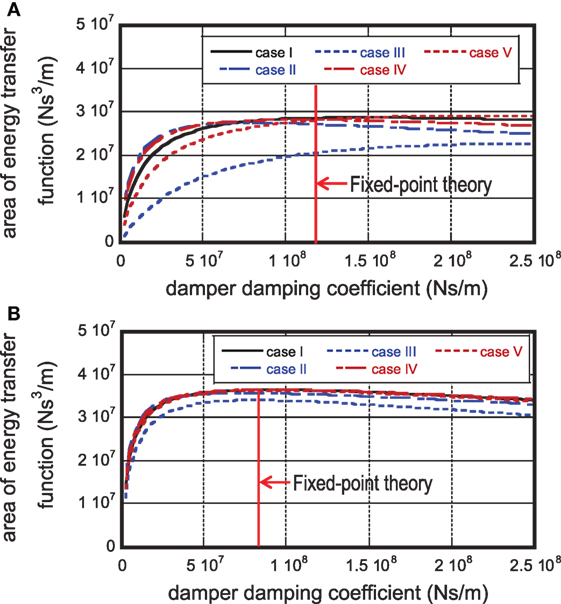
Figure 8. Energy transfer function for five models (Cases I, II, III, IV, and V) of various damper distributions with respect to total damping coefficient of connecting damper: (A) building-connection system and (B) dual control system.
Earthquake Responses of Proposed Building Model and Other Comparable Model
In this section, the earthquake responses of the proposed building model and the other comparable model are shown for a near-fault pulse-type ground motion and a long period, long duration far-fault ground motion. Based on these results, the robustness of the proposed building model is demonstrated.
Input Ground Motions
As the representative ground motions, a far-fault (long duration) ground motion (Tonankai-Nankai: the fault zone is located along the south of Japan island) and a near-fault ground motion 1 (Uemachi-Dansotai: the fault is under Osaka city in Japan) have been chosen. The velocity response spectra (5% damping) of these ground motions together with other two motions (near-fault ground motion 2 in Uemachi-Dansotai and spectrum-compatible ground motion with random phase angle and the maximum input velocity of 0.5 m/s) are shown in Figure 9. Two other ground motions are shown in Figure 9 because the comparison of response spectra of these four ground motions is beneficial. Especially the design spectrum used for the generation of a spectrum-compatible ground motion indicates the design code used in Japan. The design ground motions whose response spectrum for a specific damping ratio is compatible with a specified design response spectrum are often used in actual design of high-rise buildings.
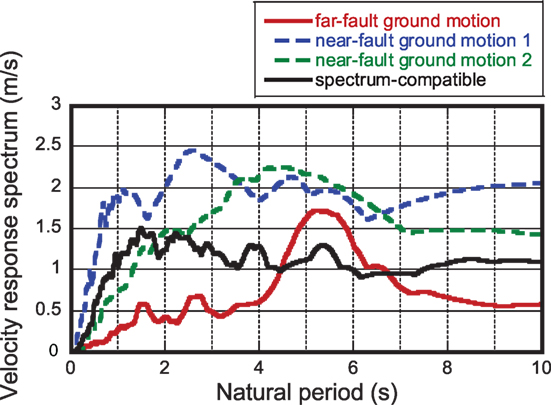
Figure 9. Velocity response spectra of four ground motions: spectrum-compatible ground motion, far-fault ground motion (Tonankai-Nankai), near-fault ground motion 1 (Uemachi-Dansotai), and near-fault ground motion 2 (Uemachi-Dansotai).
Maximum Response of Proposed Building Model with Various Locations of Middle Isolation Story and Other Comparable Model under Two Earthquake Ground Motions
Figures 10A,B show the maximum interstory drift angles of five models, explained in Figure 7, of the dual control system under a far-fault ground motion and a near-fault ground motion. These responses have been obtained by using SNAP (2015). On the other hand, Figures 10C,D present those of the building-connection model. It can be observed that the proposed dual control system exhibits the lower responses of the maximum interstory drift angles under both the far-fault and near-fault ground motions compared to the conventional building-connection system. Furthermore, Case II (with dampers allocated to upper stories) exhibits a good performance in general except in upper stories of the building-connection system under the near-fault ground motion. This may be related to the whipping phenomenon in upper stories.
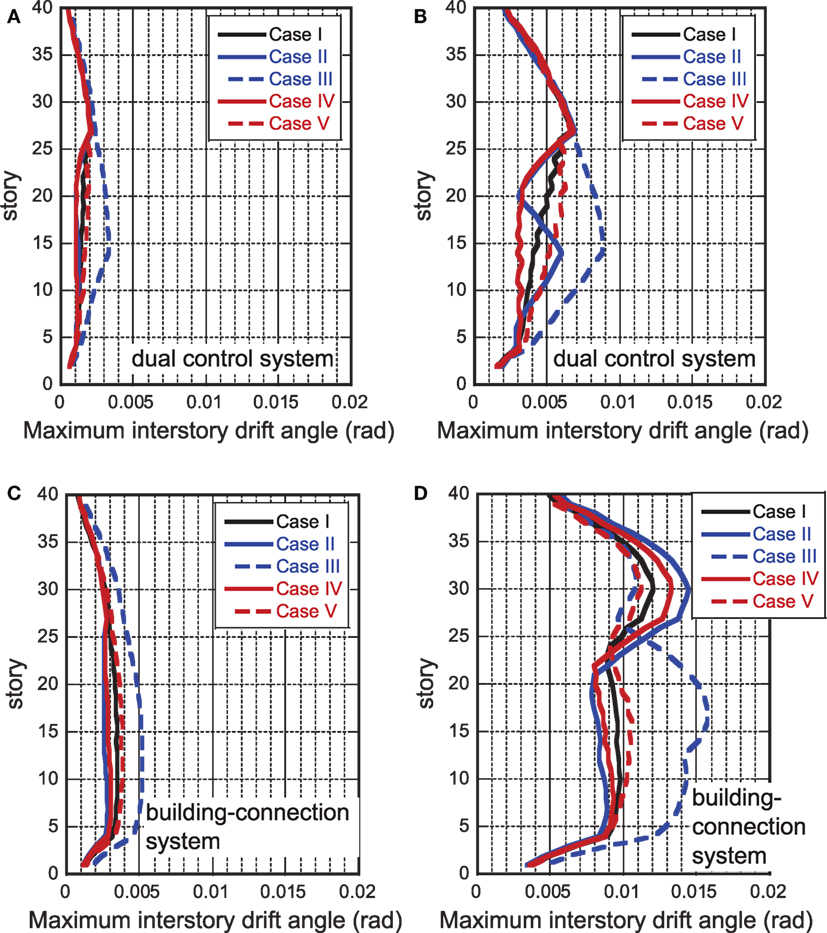
Figure 10. Maximum interstory drift angle of five models of dual control system and building-connection system under far-fault or near-fault ground motions: (A) dual control system under far-fault ground motion, (B) dual control system under near-fault ground motion 1, (C) building-connection system under far-fault ground motion, and (D) building-connection system under near-fault ground motion 1.
Investigation on Robustness of Dual System via Impulse Inputs
In order to demonstrate the robustness of the high-rise residential house including the proposed dual passive control system for a broader class of earthquake ground motions, a double impulse (Fukumuto and Takewaki, 2015; Kojima and Takewaki, 2015a) as a representative of an impulsive earthquake ground motion and a multiple impulse (Fukumuto and Takewaki, 2015; Kojima and Takewaki, 2015b) as a representative of a long duration earthquake ground motion are used. The interval of the double impulse and the multiple impulse is denoted by t0 (half of the period of a sinusoidal wave). The normalized earthquake input energy EI/(mV2) is used as the measure for investigating the influence of the earthquake ground motion.
Figures 11A,B present the normalized earthquake input energy EI/(mV2) of the conventional building-connection system and the proposed dual control system under the double impulse with respect to interval t0 of the double impulse. The method for obtaining this normalized earthquake input energy can be found in Fukumuto and Takewaki (2015). It can be observed from Figures 11A,B that while the conventional building-connection system exhibits a remarkable amplification under a double impulse with a specific interval, the proposed dual control system does not. This may be due to that fact that the natural period difference between the main structure (base-isolated) and the substructure (free wall) is noticeable in the proposed dual control system and the effectiveness of dampers is large in the proposed dual control system. Figures 11C,D show the normalized earthquake input energy EI/(mV2) of the conventional building-connection system and the proposed dual control system under the multiple impulse with respect to interval t0 of the multiple impulse. It can be observed that the conventional building-connection system exhibits more remarkable response amplification compared to the proposed dual control system. It may be related to the fact that the resonance is remarkable under the long-duration input. Furthermore, as seen under the double impulse, it can be observed that while the conventional building-connection system exhibits a remarkable amplification under a multiple impulse with a specific interval, the proposed dual control system does not.
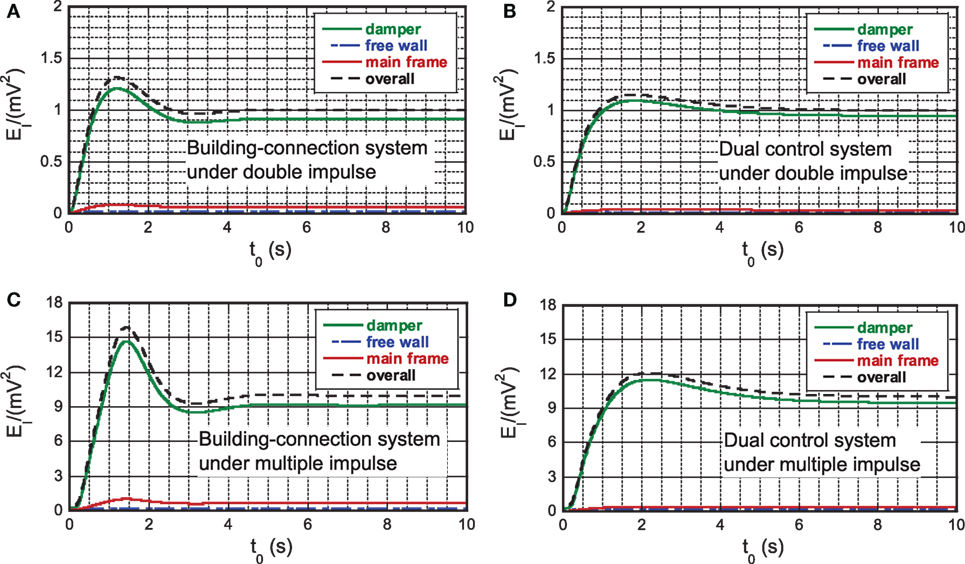
Figure 11. Normalized earthquake input energy EI/(mV2) under double impulse or multiple impulse with respect to impulse interval t0: (A) building-connection system under double impulse, (B) dual control system under double impulse, (C) building-connection system under multiple impulse, and (D) dual control system under multiple impulse.
It can be concluded that the proposed dual control system possesses a robuster property against a broad type of earthquake ground motions with various parameters, e.g., predominant period of input.
Investigation of Dual Control System Using Three-Dimensional Frame Model
Consider a realistic 41-story reinforced concrete high-rise residential house, shown in Figure 12, which includes a base-isolation system and is connected to the reinforced concrete shear wall (parking tower). An almost equivalent building with the proposed dual control system has been constructed in Tokyo bay area. The details of isolators and connecting oil dampers are shown in Table 1. In Sections “Dual Passive Control System Using Base Isolation and Building Connection” and “Effective Damper Distribution,” the main building has been modeled into a shear-bending model of 40 masses and the shear wall has also been modeled into a shear-bending model of 26 masses. However, in this section, the proposed system is analyzed using a three-dimensional frame model. All the structural elements are modeled in detail, and the P-delta effect is considered. The tangential stiffness-proportional damping matrix is used, and the initial damping ratio is 0.03. The strength reduction after the formation of plastic hinge is not considered. On the one hand, the fundamental natural period of the base-isolated model without connection is 6.85 s and that of the free wall is 0.60 s. On the other hand, the fundamental natural period of the non-isolated model without connection is 3.82 s.
In order to demonstrate the effectiveness of the proposed dual control system, the base-isolation system without connection to the shear wall (called the base-isolation system) and the interconnected building system without base isolation (called the building-connection system) are treated as the comparison models.
Consider four design earthquake ground motions introduced in Section “Input Ground Motions,” i.e., spectrum-compatible ground motion with random phase angle, far-fault ground motion (Tonankai-Nankai), near-fault ground motion 1 (Uemachi-Dansotai), and near-fault ground motion 2 (Uemachi-Dansotai). The velocity response spectra of these four ground motions were provided in Figure 9.
Figure 13 shows the maximum interstory drift angles of the proposed dual control system, the building-connection system, and the base-isolated system under the abovementioned four earthquake ground motions. It can be observed that the proposed dual control system exhibits a good performance except under the near-fault ground motion 2 (although the maximum response value is still smaller than those of other models). Especially the proposed dual control system shows an excellent performance for rather long duration ground motions keeping the response to near-fault ground motions within an allowable range.
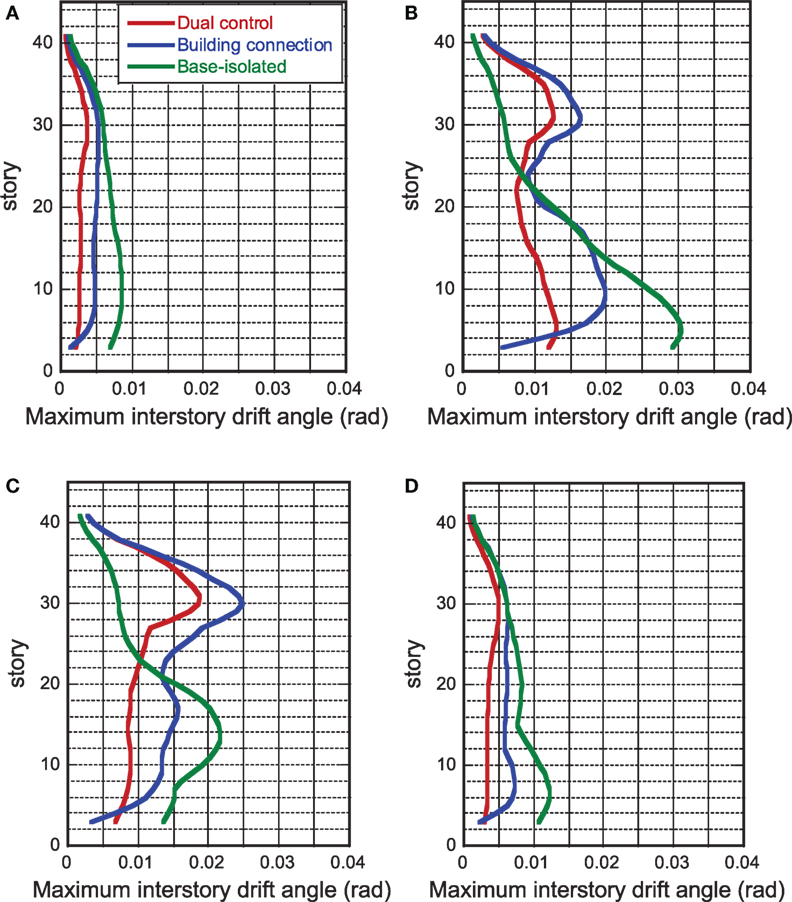
Figure 13. Maximum interstory drift angles of dual control system, building-connection system, and base-isolated system under spectrum-compatible, far-fault, and near-fault ground motions: (A) far-fault ground motion, (B) near-fault ground motion 1, (C) near-fault ground motion 2, and (D) spectrum-compatible ground motion.
Figure 14 shows the maximum horizontal displacements of the dual control system, the building-connection system, and the base-isolated system under the four ground motions, and Figure 15 presents the maximum story shear coefficients. It can be observed that the proposed dual control system exhibits a good performance except in upper stories under the near-fault ground motions.
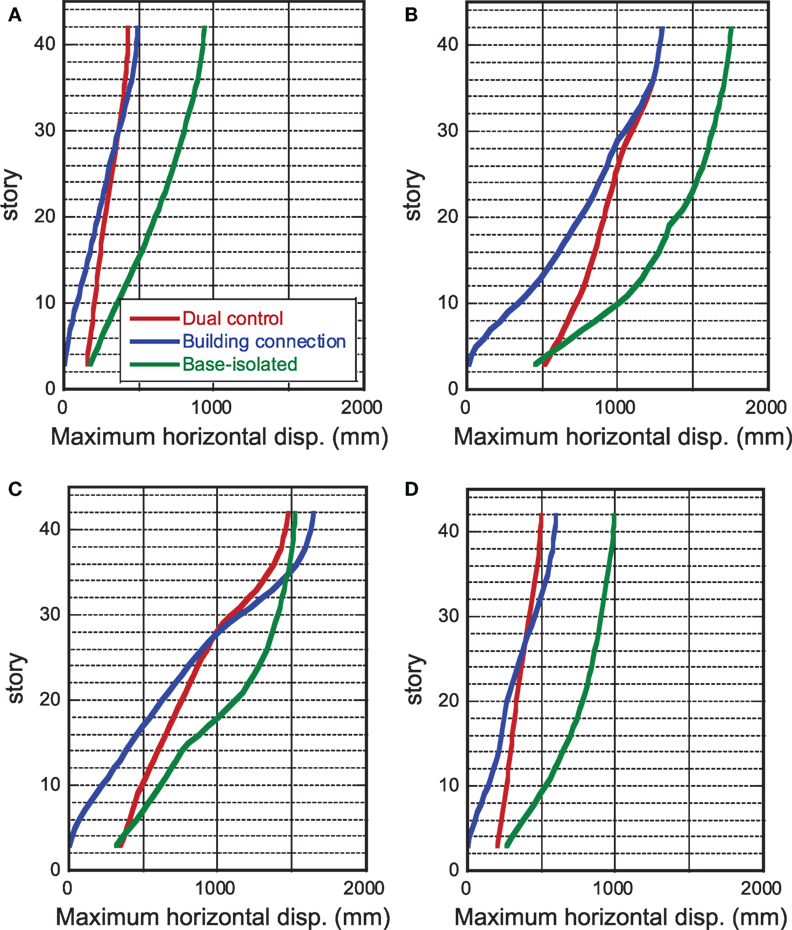
Figure 14. Maximum horizontal displacements of dual control system, building-connection system, and base-isolated system under spectrum-compatible, far-fault, and near-fault ground motions: (A) far-fault ground motion, (B) near-fault ground motion 1, (C) near-fault ground motion 2, and (D) spectrum-compatible ground motion.
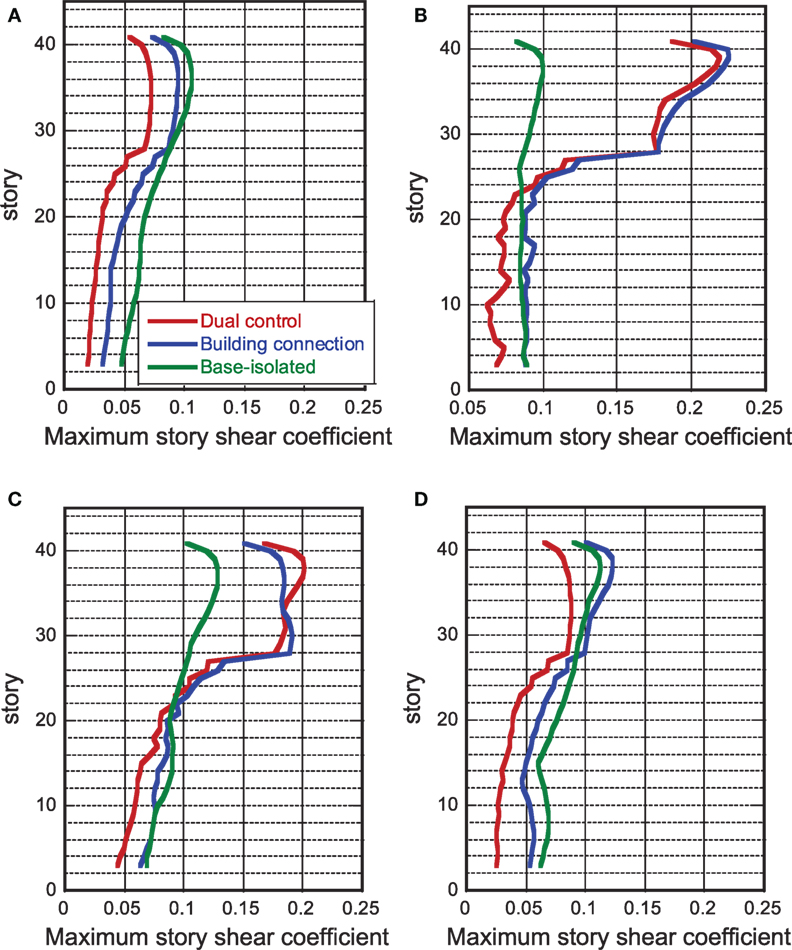
Figure 15. Maximum story shear coefficients of dual control system, building-connection system, and base-isolated system under spectrum-compatible, far-fault, and near-fault ground motions: (A) far-fault ground motion, (B) near-fault ground motion 1, (C) near-fault ground motion 2, and (D) spectrum-compatible ground motion.
Figure A1 in Appendix presents the maximum relative displacements between two buildings under the near-fault ground motion 1. It can be observed that the connecting dampers are effective in all stories in the proposed dual control system compared to the building-connection system without the base isolation. Furthermore, it can be found that the collision occurs in upper stories in the proposed dual control system because the clearance is 750 mm. A restriction on the maximum relative displacement has been introduced to model the collision. As explained in Section “Possible Scenarios in Proposed Dual Control System,” this collision is allowed in the proposed system and plays an important role for enhancing the redundancy for safety of the building. The damage reported recently during impulsive-type or long-duration-type earthquakes results mainly from the unexpected level of input. The proposed hybrid system may be able to respond to this issue because the proposed system has a large safety margin.
Conclusion
A dual building control system of base isolation and building connection has been proposed and compared with the conventional building-connection system without base isolation. The effective quantity and location of connecting dampers have also been discussed. The following conclusions have been derived:
(1) The proposed dual building control system is effective both for near-fault pulse-type ground motions and far-fault long-period, long-duration ground motions. This indicates the high robustness of the proposed dual building system for various kinds of ground motions.
(2) The transfer function of the proposed dual building control system possesses lower values in a broader frequency range compared to the conventional building-connection system. This also supports the high robustness of the proposed dual building system.
(3) The realization of the larger ratio of the fundamental natural periods between the main building and the free wall has made the proposed system effective. In the case where the main building goes into the plastic region under an unexpected earthquake ground motion, the ratio will become larger and the effectiveness of this system will become higher.
(4) The collision between two buildings is allowed in the proposed system and plays an important role for absorbing the earthquake input energy and enhancing the redundancy for safety of the building system. Since the natural period of the main building is around 7 s, the collision occurs very slowly. Therefore, no damage is expected. The concrete strength is to be designed appropriately to avoid any damage.
(5) The optimal connecting damper quantity providing a lower response of the main frame can be obtained by maximizing the area of energy transfer function, which implies the energy absorption of the connecting dampers under an idealized input with a constant Fourier spectrum. This is supported by the property that the input energy by such input to the overall system is constant regardless of the structural properties if the total mass of the structure is the same (Takewaki, 2007). Then, if the energy absorption of the connecting dampers becomes larger, the energy input into the buildings becomes smaller. Furthermore, the effective connection damper location can be achieved by locating dampers at upper stories where larger interbuilding displacements are realized.
While the proposed system has many advantages described above, it has some drawbacks, high cost, and restriction on the usage of buildings [necessity of the free wall (parking tower)]. However, the problem of cost will be overcome once many buildings with the proposed system are constructed in the near future.
Author Contributions
YF carried out the theoretical and numerical analysis. IT supervised the theoretical analysis.
Conflict of Interest Statement
The authors declare that the research was conducted in the absence of any commercial or financial relationships that could be construed as a potential conflict of interest.
Acknowledgments
The authors are grateful to Prof. K. Fujita of Kyoto University for his valuable comments and help in the numerical examples.
Funding
Part of the present work is supported by the Grant-in-Aid for Scientific Research (KAKENHI) of Japan Society for the Promotion of Science (No. 15H04079) and Sumitomo Rubber Industries, Co. This support is greatly appreciated.
References
Amadio, C., Fragiacomo, M., and Rajgelj, S. (2003). The effects of repeated earthquake ground motions on the non-linear response of SDOF systems. Earthq. Eng. Struct. Dyn. 32, 291–308. doi: 10.1002/eqe.225
Ariga, T., Kanno, Y., and Takewaki, I. (2006). Resonant behavior of base-isolated high-rise buildings under long-period ground motions. Struct. Des. Tall Special Build. 15, 325–338. doi:10.1002/tal.298
Becker, T., and Ezazi, A. (2016). Enhanced performance through a dual isolation seismic protection system. Struct. Des. Tall Special Build. 25, 72–89. doi:10.1002/tal.1229
Ben-Haim, Y. (2006). Information-Gap Decision Theory: Decisions under Severe Uncertainty. London: Academic Press.
Bruneau, M., and Reinhorn, A. (2006). “Overview of the resilience concept,” in Proceedings of the 8th US National Conference on Earthquake Engineering. San Francisco.
Fujita, K., Miura, T., Tsuji, M., and Takewaki, I. (2016). Experimental study on influence of hardening of isolator in multiple isolation building. Front Built Environ. 2:12. doi:10.3389/fbuil.2016.00012
Fukumuto, Y., and Takewaki, I. (2015). Critical demand of earthquake input energy to connected building structures. Earthq. Struct. 9, 1133–1152. doi:10.12989/eas.2015.9.6.1133
Hall, J. H., Heaton, T. H., Halling, M. W., and Wald, D. J. (1995). Near-source ground motion and its effect on flexible buildings. Earthq. Spectra 11, 569–605.
Hashimoto, T., Fujita, K., Tsuji, M., and Takewaki, I. (2015). Innovative base-isolated building with large mass-ratio TMD at basement. Int. J. Future Cities Environ. 1, 9.
Heaton, T. H., Hall, J. H., Wald, D. J., and Halling, M. W. (1995). Response of high-rise and base-isolated buildings in a hypothetical MW 7.0 blind thrust earthquake. Science 267, 206–211.
Hino, J., Yoshitomi, S., Tsuji, M., and Takewaki, I. (2008). Bound of aspect ratio of base-isolated buildings considering nonlinear tensile behavior of rubber bearing. Struct. Eng. Mech. 30, 351–368. doi:10.12989/sem.2008.30.3.351
Irikura, K., Kamae, K., and Kawabe, H. (2004). “Importance of prediction of long-period ground motion during large earthquakes,” in Annual Conference of the Seismological Society of Japan, Poster Session. Fukuoka. (in Japanese).
Jangid, R. S. (1995). Optimum isolator damping for minimum acceleration response of base-isolated structures. Aust. Civ. Eng. Trans. 37, 325–331.
Jangid, R. S., and Datta, T. K. (1994). Non-linear response of torsionally coupled base isolated structure. J. Struct. Eng. ASCE 120, 1–22.
Jangid, R. S., and Kelly, J. M. (2001). Base isolation for near-fault motions. Earthq. Eng. Struct. Dyn. 30, 691–707.
Kamae, K., Kawabe, H., and Irikura, K. (2004). “Strong ground motion prediction for huge subduction earthquakes using a characterized source model and several simulation techniques,” in Proceedings of the13th WCEE (Vancouver).
Karabork, T. (2011). Performance of multi-storey structures with high damping rubber bearing base isolation systems. Struct. Eng. Mech. 39, 399–410. doi:10.12989/sem.2011.39.3.399
Kasagi, M., Fujita, K., Tsuji, M., and Takewaki, I. (2016). Effect of nonlinearity of connecting dampers on vibration control of connected building structures. Front. Built Environ. 1:25. doi:10.3389/fbuil.2015.00025
Kasagi, M., Fujita, K., Tsuji, M., and Takewaki, I. (2016). Automatic generation of smart earthquake-resistant building system: hybrid system of base-isolation and building-connection. J. Heliyon 2, 2. doi:10.1016/j.heliyon.2016.e00069
Kobori, T. (2004). Seismic-Response-Controlled Structure (New Edition). Tokyo: Kajima Publisher. (in Japanese).
Kojima, K., and Takewaki, I. (2015a). Critical earthquake response of elastic–plastic structures under near-fault ground motions (Part 1: Fling-step input). Front. Built. Environ. 1:12. doi:10.3389/fbuil.2015.00012
Kojima, K., and Takewaki, I. (2015b). Critical input and response of elastic–plastic structures under long-duration earthquake ground motions. Front. Built. Environ. 1:15. doi:10.3389/fbuil.2015.00015
Koo, J.-H., Jang, D.-D., Usman, M., and Jung, H.-J. (2009). A feasibility study on smart base isolation systems using magneto-rheological elastomers. Struct. Eng. Mech. 32, 755–770. doi:10.12989/sem.2009.32.6.755
Li, H.-N., and Wu, X.-X. (2006). Limitations of height-to-width ratio for base-isolated buildings under earthquake. Struct. Des. Tall Special Build. 15, 277–287. doi:10.1002/tal.295
Morales, C. A. (2003). Transmissibility concept to control base motion in isolated structures. Eng. Struct. 25, 1325–1331. doi:10.1016/S0141-0296(03)00084-1
Murase, M., Tsuji, M., and Takewaki, I. (2013). Smart passive control of buildings with higher redundancy and robustness using base-isolation and inter-connection. Earthq. Struct. 4, 649–670. doi:10.12989/eas.2013.4.6.649
Patel, C. C., and Jangid, R. S. (2011). Dynamic response of adjacent structures connected by friction dampers. Earthq. Struct. 2, 149–169. doi:10.12989/eas.2011.2.2.149
Petti, L., Giannattasio, G. M., De Iuliis, M., and Palazzo, B. (2010). Small scale experimental testing to verify the effectiveness of the base isolation and tuned mass dampers combined control strategy. Smart Struct. Sys. 6, 57–72. doi:10.12989/sss.2010.6.1.057
SNAP. (2015). An Elastic-Plastic Analysis Program for Arbitrary-Shape Three-Dimensional Frame Structures, Ver.6.1. Tokyo: Kozo System, Inc.
Takewaki, I. (2005). Uncertain-parameter sensitivity of earthquake input energy to base-isolated structure. Struct. Eng. Mech. 20, 347–362. doi:10.12989/sem.2005.20.3.347
Takewaki, I. (2007). Earthquake input energy to two buildings connected by viscous dampers. J. Struct. Eng. ASCE 133, 620–628. doi:10.1061/(ASCE)0733-9445(2007)133:5(620)
Takewaki, I. (2008). Robustness of base-isolated high-rise buildings under code-specified ground motions. Struct. Des. Tall Special Build. 17, 257–271. doi:10.1002/tal.350
Takewaki, I. (2013). Critical Excitation Methods in Earthquake Engineering, 2nd Edn. Amsterdam: Elsevier Science.
Takewaki, I., and Fujita, K. (2009). Earthquake input energy to tall and base-isolated buildings in time and frequency dual domains. Struct. Des. Tall Special Build. 18, 589–606. doi:10.1002/tal.497
Takewaki, I., Fujita, K., and Yoshitomi, S. (2013). Uncertainties in long-period ground motion and its impact on building structural design: case study of the 2011 Tohoku (Japan) earthquake. Eng. Struct. 49, 119–134. doi:10.1016/j.engstruct.2012.10.038
Takewaki, I., Moustafa, A., and Fujita, K. (2012). Improving the Earthquake Resilience of Buildings: The Worst Case Approach. London: Springer.
Takewaki, I., Murakami, S., Fujita, K., Yoshitomi, S., and Tsuji, M. (2011). The 2011 off the Pacific coast of Tohoku earthquake and response of high-rise buildings under long-period ground motions. Soil Dyn. Earthq. Eng. 31, 1511–1528. doi:10.1016/j.soildyn.2011.06.001
Appendix
Analysis of Collision of Two Buildings
Figure A1 shows the maximum relative displacements between two buildings (residential house and parking tower) under the near-fault ground motion 1.
Keywords: dual passive control, high-rise building, robustness, redundancy, base isolation, building connection
Citation: Fukumoto Y and Takewaki I (2017) Dual Control High-rise Building for Robuster Earthquake Performance. Front. Built Environ. 3:12. doi: 10.3389/fbuil.2017.00012
Received: 13 December 2016; Accepted: 08 February 2017;
Published: 28 February 2017
Edited by:
Solomon Tesfamariam, University of British Columbia, CanadaReviewed by:
Vagelis Plevris, Oslo and Akershus University College, NorwayHossein Mostafaei, FM Global, USA
Copyright: © 2017 Fukumoto and Takewaki. This is an open-access article distributed under the terms of the Creative Commons Attribution License (CC BY). The use, distribution or reproduction in other forums is permitted, provided the original author(s) or licensor are credited and that the original publication in this journal is cited, in accordance with accepted academic practice. No use, distribution or reproduction is permitted which does not comply with these terms.
*Correspondence: Izuru Takewaki, takewaki@archi.kyoto-u.ac.jp
 Yoshiyuki Fukumoto
Yoshiyuki Fukumoto Izuru Takewaki
Izuru Takewaki